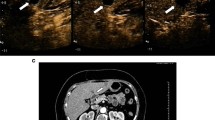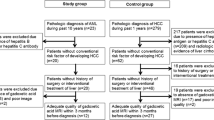Abstract
Peritumoral fat-spared area (PTFSA), a focal spared area surrounding hepatic tumors, is a specific finding of liver tumors in fatty livers. PTFSA mimics a liver tumor, making it difficult to recognize the tumor boundary. We report a case of a 56-year-old man with fatty liver who was diagnosed with a liver tumor. Ultrasonography (US) revealed a nearly homogeneous hyperechoic liver tumor measuring 40 mm in the left lobe. A thick hypoechoic area was observed around the tumor that spread more widely than an ordinary halo. Histological examination revealed that the hypoechoic area comprised a thin fibrous capsule and normal liver parenchyma without fat, which is PTFSA. Contrast-enhanced US (CEUS) indicated corona enhancement only at the inner part of the PTFSA. The inner part showed the same pattern as that of an ordinary halo and was a part of hepatocellular carcinoma, whereas the outer part showed the same pattern as that of the other liver parenchyma. CEUS was an effective modality for distinguishing the difference. Thus, CEUS was useful in defining the tumor boundary. Before initiating treatment, tumors should be evaluated using various modalities to detect their accurate boundary. CEUS may be a useful modality for detecting the boundary and making a diagnosis.





Similar content being viewed by others
References
Amarapurkar DN, Hashimoto E, Lesmana LA, et al. How common is non-alcoholic fatty liver disease in the Asia-Pacific region and are there local differences? J Gastroenterol Hepatol. 2007;22:788–93.
Baffy G, Brunt EM, Caldwell SH. Hepatocellular carcinoma in non-alcoholic fatty liver disease: an emerging menace. J Hepatol. 2012;56:1384–91.
Konno K, Ishida H, Sato M, et al. Liver tumors in fatty liver: difficulty in ultrasonographic interpretation. Abdom Imaging. 2001;26:487–91.
Gabata T, KadoyaM Matsui O, et al. Peritumoral spared area in fatty liver: correlation between opposed-phase gradient-echo MR imaging and CT arteriography. Abdom Imaging. 2001;26:384–9.
Murakami T, Kim T, Sugiura T, et al. Focally spared area of fatty liver that receives blood passing through the sinusoids of a hypervascular hepatocellular carcinoma. J Comput Assist Tomogr. 1999;23:320–2.
Terminology and Diagnostic Criteria Committee, Japan Society of Ultrasonics in Medicine. Ultrasound diagnostic criteria for hepatic tumors. J Med Ultrason. 2014;41:113–23.
Chen RC, Li CS, Lii JM, et al. Peritumoral fat-spared area is well correlated with the presence of temporal peritumoral enhancement in hepatic hemangioma in fatty liver. J Magn Reson Imaging. 2005;22:86–91.
Fujikawa K, Shiraki K, Ito T, et al. Focal spared area in fatty liver mimicking a tumor. Hepatogastroenterology. 2002;49:1253–4.
Wernecke K, Henke L, Vassallo P, et al. Pathologic explanation for hypoechoic halo seen on sonograms of malignant liver tumors: an in vitro correlative study. AJR Am J Roentgenol. 1992;159:1011–6.
Nakagawara H, Ogawa M, Matsumoto N, et al. Evaluation of malignancy of hepatocellular carcinoma using the ultrasonic B-mode method: clinical significance of extracapsular invasion of hepatocellular carcinoma using ultrasonography. J Med Ultrason. 2007;34:83–91.
Toshikuni N, Tsutsumi M, Takuma Y, et al. Real-time image fusion for successful percutaneous radiofrequency ablation of hepatocellular carcinoma. J Ultrasound Med. 2014;33:2005–10.
Isozaki T, Numata K, Kida T, et al. Differential diagnosis of hepatic tumors by using contrast enhancement patterns at US. Radiology. 2003;229:798–805.
Kita R, Sakamoto A, Nagata Y, et al. Visualization of blood drainage area from hypervascular hepatocellular carcinoma on ultrasonographic images during hepatic arteriogram: comparison with depiction of drainage area on contrast-enhanced ultrasound. Hepatol Res. 2012;42:999–1007.
Author information
Authors and Affiliations
Corresponding author
Ethics declarations
Conflict of interest
The authors declare that they have no conflicts of interest.
Human rights statement
All procedures followed were in accordance with the ethical standards of the responsible committee on human experimentation (institutional and national) and with the Helsinki Declaration of 1964 and later versions.
Informed consent
Informed consent was obtained from the patient for being included in the report.
About this article
Cite this article
Ikeda, A., Oiwa, Y. & Kokuryu, H. Contrast-enhanced ultrasonography evaluation of hepatocellular carcinoma with peritumoral fat-spared area: a case report. J Med Ultrasonics 45, 325–329 (2018). https://doi.org/10.1007/s10396-017-0822-5
Received:
Accepted:
Published:
Issue Date:
DOI: https://doi.org/10.1007/s10396-017-0822-5




